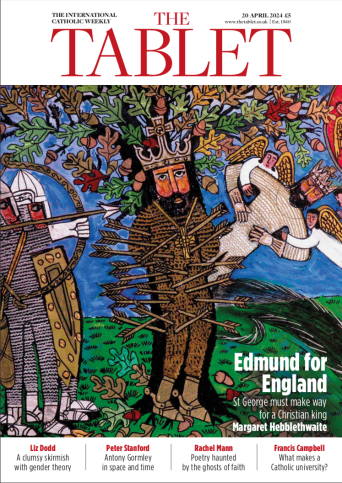Reviewed by Melanie McDonagh
Yale UNIVERSITY PRESS, 400pp, £25
Tablet Bookshop price £22.50
Tel 01420 592974
Pagan Britain isn’t just another way of saying “Prehistoric Britain”, the shadowy millennia from the first settlement of the island until Roman times and beyond; this wonderful book is precisely what it says on the cover, an attempt to say something about pre-Christian religion. Ronald Hutton ponders at the outset whether it’s possible to say anything useful at all about this subject, given the limitations of the evidence and its openness to endless, quite different readings. This could, in other hands, be a source of weakness, but for Hutton it’s an endlessly good thing that we can project so many interpretations on to prehistory, so long as we’re clear about what we’re doing and respect the established facts.
The attempt to engage at all with the question of religion does, of course, raise some basic questions about the religious instinct in man. “What is quite clear”, says Hutton, “is that our own species, Homo sapiens, manifested every sign of possessing the necessary imaginative faculty [for religious belief] as soon as it evolved, whether as a result of evolution, as most Western scholars now believe, or as a divine gift, as is still the opinion of some adherents to certain faiths. Every test of evidence … has yielded an unequivocal result … and especially in two areas: the ceremonial burial of the dead, and the production of painted or carved representations … Together with other traces of a heightened sense of imagination and of symbolic behaviour … these activities attest strongly to a capacity to conceive of worlds beyond the material and the immediate.”
Tablet readers will no doubt want to contest the assumption that the origin of religion is just a toss-up between evolution or divine gift – given that God’s gifts can come through the medium of evolution as easily as any other – but this is to say something crucial about man, and our capacity to apprehend realities beyond our physical environment and appetites – including our sexual appetite. Hutton remarks that “Old Stone Age picture-makers seem to have been remarkably uninterested in the act of sex.” Which puts in their place those scholars who assumed that early man’s creativity was to do either with hunting magic or fertility magic. These academics were, Hutton observes, a product of “an age deeply concerned with science and technology, and predisposed to interpret ancient ritual as an attempt to secure the practical benefits eventually produced by those forces”. His running theme, in fact, is that interpretations of the ancient past almost always say more about us than about it.
Hutton, professor of history at the University of Bristol, is best known for his book on the ritual year in England, The Rise and Fall of Merry England, which draws chiefly on late-medieval sources. Pagan Britain is about an altogether larger, more mysterious and inaccessible period. It is a profoundly agnostic book – not that the author is irreligious (he’s something of a pagan himself) but in the sense that it celebrates not-knowing. For practically every artefact, human remains and structure Hutton discusses, he makes clear that what we don’t know is far greater than what we do. In discussing the henges of the late Neolithic period, for instance, he goes through half a dozen possibilities for their purpose before concluding: we just don’t know.
What’s plain is that we cannot simply project ourselves upon the long-dead past. Hutton’s discussion of Paleolithic pictures demonstrates the strangeness, the otherness of the pre-Christian mindset. What are we to make of these paintings, set so deep inside a cave that they can only be seen by a spectator lying on his side? Or of apparently abstract Stone Age imagery, which equals the sum of the apparently representational? Or those pictures which seem to suggest that successive individuals painted over one area – one possibility being that the act of making was what mattered, rather than the act of looking. And what about images made for ritual destruction? Hutton’s laconic observations on some of the Paleolithic images reproduced here sum up the vagaries of interpretation. They could be, he suggests: “a) ‘dancing masked man’ … all details of this interpretation are in doubt; ... d) Shapes taken by some to be dancing women and by others to be long-necked birds; e) So-called vulva figures – female genitalia or animal tracks, or something else altogether.” See what I mean?
What Hutton shows is that each period brings to the distant past the preoccupations of the present. The Victorians could interpret changes in the material of prehistory in the light of invasion and colonisation and race. In our own time, virtually all the material that the Victorians interpreted as evidence of primitive atrocity have been given a benign interpretation, often on an even more slender basis.
In the Seventies, feminists enthusiastically embraced the idea of the Great Goddess, for obvious reasons, and Marxists embraced the notion of the theory of chiefdoms. The advent of political correctness has meant foreign presence is seen like modern immigration – a welcome influx. Hutton’s account of the battery of preoccupations that have been brought to interpretations of Stonehenge could make a book in itself.
And this is precisely his point. “To admit how much we cannot know and then to turn that into an opportunity and a strength rather than an embarrassment and a handicap ... makes the point that where the past is concerned, what is open-ended, subjective, multivalent and individual can be as valuable as what is fixed and certain.” That certainly tells us a great deal about Ronald Hutton.



 Loading ...
Loading ...
What do you think?
You can post as a subscriber user...
User Comments (0)